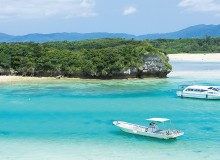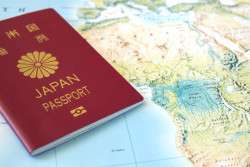
October 7, 2010
Toyako Onsen
Listen for rumblings at a Hokkaido lake that never freezes
By Metropolis
Originally published on metropolis.co.jp on October 2010

Photos by Kimi Jackson
One day it was a farmer’s wheat field, the next it was the tip of a mountain surging forth from the ground. Showa Shinzan (“New Showa Mountain”) emerged during a series of earthquakes in 1944, and over the following two years the lava dome rose to a height of nearly 400 meters. Still smoking and belching fumes today, it sits next to the larger Mt. Usu, within the Shikotsu-Toya National Park in Hokkaido. Together with Toyako Onsen, it makes an excellent side trip from Sapporo, with opportunities for hiking, cycling, fireworks and the chance to soak your tired feet in the free local hot baths.

I made my way to Toyako Onsen by bus from Sapporo, struggling to pronounce the name of my youth hostel in a way that the driver could understand. After checking in, I rented a bicycle and commenced the short but steep—not to mention misty—ride up to the base of Showa Shinzan. The rocky outcropping towers over tacky tourist shops and sad caged bears that perform tricks for food, surrounded by a grove of trees and flanked by an attractive walking path.
Japanese officials saw the sudden emergence of Showa Shinzan during World War II as a bad omen and tried to hush it up, even asking locals to douse the volcanic flames to hide them from the view of Allied forces. A local postmaster took it upon himself to document the emergence and growth of the lava dome, and his records are preserved in a small museum at the base. The cable car up Mt. Usu, one of Japan’s most active volcanoes, offers more panoramic views of the peak.
The nearly spherical Lake Toya, just steps from Showa Shinan Youth Hostel, is Japan’s ninth-largest lake. Four islands lie at the center of this volcanic caldera, themselves comprised of seven lava domes, and it’s surrounded by still more active volcanoes. The lake is noted for its clarity, along with the fact that it never freezes in winter due to geothermal activity.
The next morning, aided by an excellent map provided by the tourist office at Sapporo station, I rented a mama chari and set out to ride the 50km around Lake Toya. The journey took me on a little-used country road past fields of flowers, charming A-frame camping cabins, an elderly woman working in a field with what looked like a machete, and sculptures of larger-than-life, busty naked women.

In all, it was a leisurely six-hour ride along the forested shore, offering beautiful views of the lake and the various volcanoes around it. I got back to Toyako Onsen in time to soak my feet in one of the town’s free footbaths and eat dinner before heading back to the shore to watch the evening fireworks show, which takes place every day from April 28 through October 31, weather permitting.
A stop at a few of Toyako Onsen’s sights rounds out a visit to the area. The Volcano Science Museum tells the story of Mt. Usu’s many eruptions, the most recent of which, in 2000, destroyed numerous buildings but didn’t lead to any fatalities. The peak is known as the “Mountain that Never Lies” because its eruptions always follow a large earthquake, making timely evacuations possible. In the Konpira Crater Hazard Area, visitors can observe the remains of buildings destroyed by eruptions and bridges washed away by the mudflow. If you want to get even closer to the volcanic action, check out the Nishiyama Crater Promenade just outside of town, which meanders past smoking live craters.
Trip Tips

There are buses to Toyako Onsen from Shin-Chitose Airport (2hr, 30min) and Sapporo (2hr, 40min), and it’s a 20min ride from JR Toya station. If you’re coming by ferry, the closest ports are Tomakomai (1hr, 30min) and Muroran (1hr). The visitor center is open 9am-5pm, and there is more tourist information available at www.laketoya.com/en. Toyako Onsen has a range of accommodation options, Showa Shinan Youth Hostel (http://meturl.com/showashinan) being one of the cheapest.







